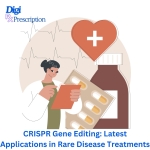Introduction
The revolutionary CRISPR gene-editing technology is transforming the way we treat genetic disorders. Initially discovered as a tool for editing DNA, CRISPR is now being used to correct mutations responsible for rare diseases like sickle cell anemia, muscular dystrophy, and cystic fibrosis. Recent advancements have brought us closer to curing previously untreatable conditions, offering hope to millions of patients worldwide.
In this article, we explore the latest breakthroughs in CRISPR-based treatments and how this technology is shaping the future of medicine.
1. What is CRISPR Gene Editing?
How Does CRISPR Work?
CRISPR (Clustered Regularly Interspaced Short Palindromic Repeats) is a genetic tool that allows scientists to precisely edit DNA by cutting and replacing specific genetic sequences. It acts like molecular scissors, enabling researchers to fix mutations that cause genetic diseases.
CRISPR vs. Traditional Gene Therapy
???? CRISPR directly edits faulty genes, whereas traditional gene therapy introduces new genes to compensate for defective ones.
???? Permanent correction of genetic defects, unlike some therapies that require repeated treatments.
???? More precise and cost-effective, making it accessible for various diseases.
2. CRISPR in Treating Sickle Cell Anemia
Breakthroughs in Sickle Cell Treatment
Sickle cell anemia is a painful and life-threatening blood disorder caused by a mutation in the HBB gene, leading to misshapen red blood cells that block blood flow.
Recent CRISPR-based therapies, such as Exa-cel (developed by Vertex Pharmaceuticals and CRISPR Therapeutics), have demonstrated remarkable success in clinical trials, effectively curing some patients.
How CRISPR Treats Sickle Cell Anemia:
- Bone marrow cells are extracted from the patient.
- CRISPR edits the faulty HBB gene or activates the production of fetal hemoglobin (HbF), which prevents sickle cell formation.
- The modified cells are reinfused, leading to the production of healthy red blood cells.
Success Stories:
✔ In 2023, the FDA approved Exa-cel, making it the first-ever CRISPR-based therapy for sickle cell disease.
✔ Clinical trials showed that over 90% of patients were free from severe pain crises after treatment.
Challenges:
???? High cost (estimated at $1-2 million per patient).
???? Requires bone marrow transplantation, which involves risks.
???? Long-term effects are still being studied.
3. CRISPR for Muscular Dystrophy (Duchenne's Disease)
How CRISPR is Offering Hope to DMD Patients
Duchenne muscular dystrophy (DMD) is a fatal genetic disorder caused by mutations in the DMD gene, leading to progressive muscle weakening.
Researchers are using CRISPR to repair the defective DMD gene and restore normal muscle function.
Recent Advances in CRISPR for DMD:
???? In 2023, scientists successfully used CRISPR to restore dystrophin protein (essential for muscle strength) in animal models.
???? Early-stage human trials have shown improvements in muscle function.
???? Single-dose CRISPR therapy could potentially replace lifelong treatments.
Challenges:
???? Delivering CRISPR effectively to all muscle cells is difficult.
???? Immune system reactions to gene editing need to be managed.
???? Long-term safety remains uncertain.
4. CRISPR in Cystic Fibrosis Treatment
Gene Editing to Correct CFTR Mutations
Cystic fibrosis (CF) is a deadly lung disease caused by mutations in the CFTR gene, leading to thick mucus buildup in the lungs.
Researchers are exploring CRISPR-based therapies to correct the faulty gene in lung cells, potentially offering a permanent cure.
Recent Developments:
???? Scientists have developed CRISPR-loaded nanoparticles that can deliver gene editing tools directly into lung cells.
???? Animal studies have shown successful correction of CF mutations.
???? Clinical trials for inhalable CRISPR therapies are expected to begin soon.
Challenges:
⚠ Delivering CRISPR to lung tissue is complex.
⚠ Need for precise targeting to avoid off-target effects.
⚠ Ethical and regulatory challenges.
5. The Future of CRISPR in Rare Disease Treatment
???? Next-Gen CRISPR: Prime Editing – More precise and reduces risks of accidental mutations.
???? In Vivo CRISPR Therapies – Direct gene editing inside the body, avoiding risky procedures.
???? AI in CRISPR Research – AI is helping scientists predict gene mutations and design better CRISPR treatments.
Conclusion
CRISPR gene editing is revolutionizing rare disease treatment, offering potential cures for conditions like sickle cell anemia, muscular dystrophy, and cystic fibrosis. While challenges remain—high costs, delivery methods, and long-term safety concerns—the success of recent clinical trials has brought us closer to making gene-editing therapies widely available.
With ongoing research and advancements in CRISPR technology, the future looks promising for millions of patients suffering from genetic diseases.
???? What are your thoughts on CRISPR gene editing? Do you believe it should be widely available? Share your opinion in the comments below
References:
- FDA Approval of Exa-cel for Sickle Cell Anemia: www.fda.gov
- CRISPR in Muscular Dystrophy Treatment: www.nih.gov
- CRISPR and Cystic Fibrosis Research: www.cff.org
- Harvard Medical School – The Future of CRISPR: www.health.harvard.edu

